Sweep picking (sometimes referred to as "economic picking" or "raking") is the use of a single pick stroke in one direction across at least two strings. This picking technique is extremely efficient, or economical in movement, for the picking hand. As an example, consider a run starting on the bass E string. A single downstroke of the pick can be used to play six notes if the left hand plays one note on each string and crosses all six strings.
Sweep picking is, however, all too often abused, with only the first and last notes being audible in an otherwise distorted mess. When sweeping across five or six strings, the right hand action is very easy - most players can execute a single downstroke fairly fast and with sufficient accuracy. The problem stems from trying to get the left hand to keep up with the right hand sweep. Hand synchronization is the answer. You can achieve this by using a metronome, slowing down and practicing methodically.
Remember that one of the benefits of sweep picking is to facilitate arpeggios and single note lines with wide intervals. For a newcomer to this technique, the left hand is not usually familiar with playing only one note per string - this takes practice. Hand synchronization gets more complicated when the fretting hand is playing two or more notes per string during the sweep.
To articulate the single note lines one must effectively mute (or not play) the other five strings. If any of those strings are not properly muted they can ring and help create a messy sound. This is particularly important when a high gain or distorted sound is used. Muting can be achieved by resting the right hand palm lightly on the strings close to the bridge. Also, only fret one note at a time (where possible) with the left hand. Do not hold down chord shapes with the left hand and expect to achieve single note clarity by means of only right hand muting.
The left hand can be a very effective mute for unused strings. Rest a left hand finger on the strings when possible but don't push those strings onto the frets. A combination of these left and right hand muting techniques (and patient practice) will greatly improve your sweep picking.
Example 1 is a common two octave D major arpeggio (notes D, F# and A) with the root on the A (5th) string. It is important to try and achieve equal volume for the picked notes and those that are sounded with the hammer-on or pull-off technique.
A single downstroke of the pick is used to play the first five notes. Do not take the pick away from the strings during this downstroke. The picking action must be one long downstroke, not five separate downstrokes with the pick lifting away from the string after each string is played. After the first upstroke is played, the left hand performs a pull-off from the 5th to 2nd fret on the E string. While this pull-off is happening, the pick can rest against the B string. The pick then effectively mutes the B string and is in position to continue the upstroke when the left hand moves to the B string.
Note that there should not be any left-hand barre with the first finger when playing this example. This is a single note run, not a chord.
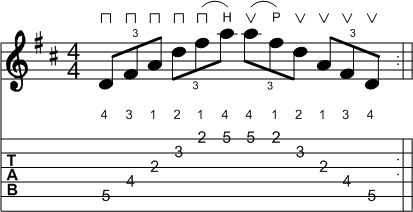
Example 2 is a simple exercise using diatonic arpeggios from the key of D major. The first four notes are part of the D major arpeggio seen in example 1. The E minor arpeggio is used for the second beat while the third beat uses the F# minor arpeggio. The fourth beat consists of a G major arpeggio. The third bar begins with an A major arpeggio that is followed by a B minor arpeggio for the last beat. Always practice with a metronome and record your playing. Listen critically to your efforts - there should be no pauses in this run as your fretting hand changes position.

Simply playing the arpeggio shapes can get boring. Try combining the arpeggio ideas with scale fragments. Example 3 is an excerpt from my composition "Electric Storm" and can be heard in the accompanying audio sample file. The common V - I (A major to D major) chord progression is used in this example.
The first bar in example 3 uses an A7 arpeggio and the second bar uses the D major arpeggio fingering shown in example 1 for the first beat but includes several scale tones during the second beat. The upstroke sweep during the second beat is broken up by pull-offs. As each pull-off is executed by the left hand, the pick rests against the next string to be picked as part of the upstroke. Think of this beat as having a single upstroke but with pauses in pick movement. Avoid lifting the pick away from the strings during this upward sweep.
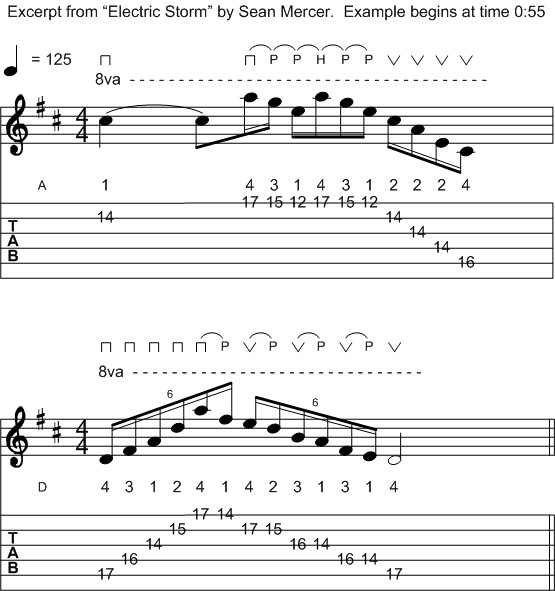
MP3 - Example 3
An extended D major arpeggio from the solo section of "Electric Storm" is shown in Example 4 and can be heard in the sample audio file. Remember that this is a single note run so avoid pressing more than one string against the frets at any time during the run. The two octave arpeggio shape shown is example 1 occurs on the second beat of this run. While the hammer-ons occur during the third beat, the picking hand should be moving into place to execute the fretboard tap at the beginning of the fourth beat.
If you have difficulty with any part of this exercise then try practicing each beat as a repetitive exercise. For example, play the first beat and then descend the same six notes during the second beat. Repeat this continuously until you have mastered that part of the run. Start slowly using a metronome and gradually increase the tempo as the material becomes familiar to you.
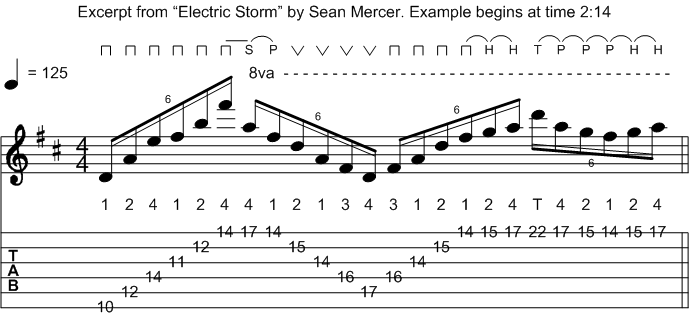
MP3 - Example 4
Example 5 is an excerpt from my instrumental "Shades of Blue" and is also featured in the accompanying audio file. This example is played over an E major backing. The first beat of this example features the same extended arpeggio shape as used during the first beat of example 4 (the 6th and 9th scale degrees are added to the basic major triad). During the second and third beats the pick rests against the next string to be picked while the hammer-ons or pulls offs are executed with the left hand.
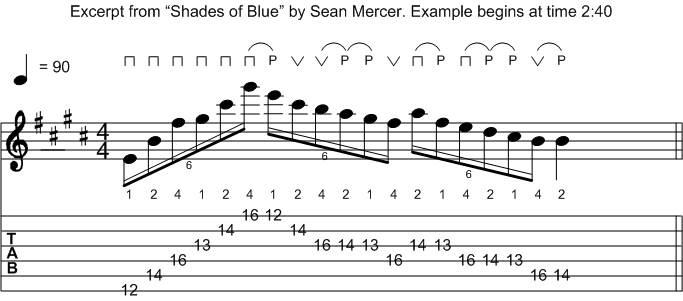
MP3 - Example 5
A four bar excerpt from my composition "Celtic Belt" is shown in example 6. A D minor arpeggio is used during the first bar and a C major arpeggio is featured in the second bar. Although this melody is not very fast there are still challenges to overcome. Make sure you can hear every note as you play the run. Try to obtain equal volume from the picked and hammered notes. Use the right hand palm for muting unintended strings, particularly the lower three strings. This is especially true when performing the hammer-ons and pull-offs on the upper strings.
The first two beats in the last bar use sixteenth notes followed by eighth note triplets in the third beat. The bass and drums also play this phrase. This example is double-tracked in the audio sample file.
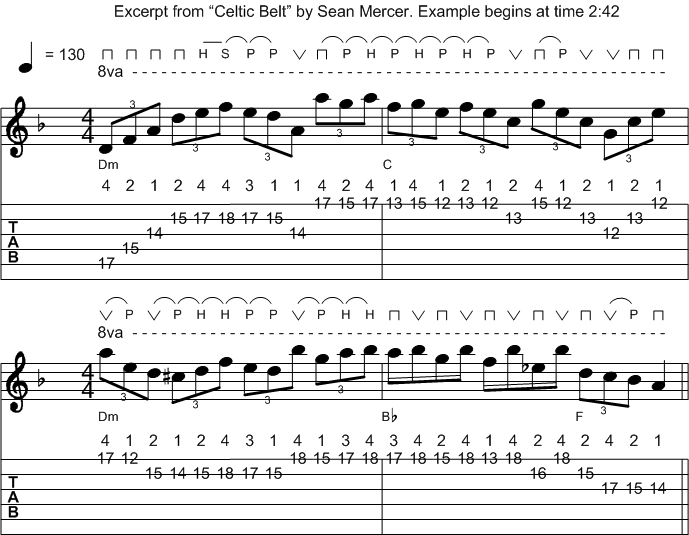
MP3 - Example 6
Example 7 is a series of C major arpeggios used in my composition "Juicy Lucy" and can be heard in the accompanying audio file. The second and fourth beats feature the same arpeggio shape shown in example 1. While the pull-off is played during the first beat the picking hand moves into position to begin the second beat. The first finger of my fretting hand is muting the B and top E strings during the first beat to prevent unintended ringing of those strings. I also use light palm muting on the other strings throughout the example.
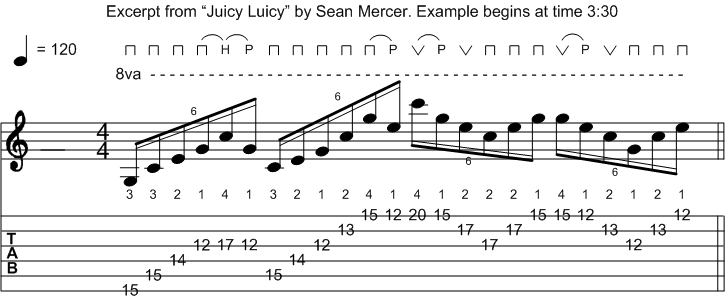
MP3 - Example 7
If you have any questions feel free to contact me through e-mail. Enjoy the workout.
Sean Mercer is an accomplished producer, engineer, writer, guitarist, and keyboardist specializing in the neo-classical metal/fusion style.
His instrumental CD is entitled "Electric Storm".